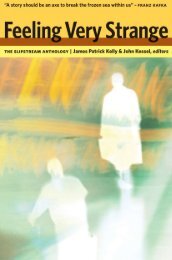The Curse of the Wer.. - Site de Thomas - Free
The Curse of the Wer.. - Site de Thomas - Free
The Curse of the Wer.. - Site de Thomas - Free
You also want an ePaper? Increase the reach of your titles
YUMPU automatically turns print PDFs into web optimized ePapers that Google loves.
164 THE CURSE OF THE WEREWOLF<br />
16. See, for example, Douglas, <strong>The</strong> Beast Within (London: Orion, 1993), pp.<br />
169–70.<br />
17. Whitney Davis, Drawing <strong>the</strong> Dream <strong>of</strong> <strong>the</strong> Wolves: Homosexuality, Interpretation,<br />
and Freud’s ‘Wolf Man’ (Bloomington and Indianapolis: Indiana<br />
University Press, 1995), p. 190.<br />
18. See, for example, Judith Halberstam, Skin Shows: Gothic Horror and <strong>the</strong><br />
Technology <strong>of</strong> Monsters (Durham NC and London: Duke University Press,<br />
1995), p. 19.<br />
19. <strong>The</strong> Wolf-Man was psychoanalysed twice by Freud, and twice by Freud’s<br />
disciple, Ruth Mack Brunswick. He became close friends with ano<strong>the</strong>r<br />
psychoanalyst, Muriel Gardiner, who encouraged him to write his memoirs<br />
later in life. For many years he received a stipend from Freud, and later<br />
<strong>the</strong> Freud Archives, in exchange for which he seems to have been tacitly<br />
expected to make himself available to psychoanalysts visiting Vienna.<br />
He also contributed his own perceptions <strong>of</strong> psychoanalysis and Freud in<br />
a variety <strong>of</strong> forums. His sense <strong>of</strong> i<strong>de</strong>ntity was so pr<strong>of</strong>oundly tied up with<br />
<strong>the</strong> psychoanalytic movement that he would frequently sign his name as<br />
‘<strong>the</strong> Wolf-Man’.<br />
20. S. Freud, ‘<strong>The</strong> Question <strong>of</strong> Lay Analysis: Conversations with an Impartial<br />
Person’, in J. Strachey (ed.), <strong>The</strong> Standard Edition <strong>of</strong> <strong>the</strong> Complete Psychological<br />
Works <strong>of</strong> Sigmund Freud, vol. 20 (London: Hogarth Press, 1959),<br />
p. 212.<br />
21. Lynne Segal, Slow Motion: Changing Masculinities, Changing Men<br />
(London: Virago, 1990), p. 70.<br />
22. R.W. Connell, Masculinities (St Leonards NSW: Allen & Unwin, 1995),<br />
p. 8.<br />
23. Ibid., p. 10.<br />
24. Ibid., p. 9.<br />
25. Dorothy Scarborough, <strong>The</strong> Supernatural in Mo<strong>de</strong>rn English Fiction<br />
(London and New York: G.P. Putnam’s Sons, 1917), p. 172.<br />
26. Richard Bagot, A Roman Mystery (London: Digby Long, 1899), p. 283.<br />
27. See, for example, H. Warner Munn, ‘<strong>The</strong> <strong>Wer</strong>ewolf <strong>of</strong> Ponkert’, Weird<br />
Tales, July 1925, reprinted in Brian J. Frost, Book <strong>of</strong> <strong>the</strong> <strong>Wer</strong>ewolf (London:<br />
Sphere, 1973), pp. 161–95; and Greye La Spina, ‘<strong>The</strong> Devil’s Pool’, Weird<br />
Tales, June 1932, pp. 728–62. This figure shared many characteristics with<br />
<strong>the</strong> Devil <strong>of</strong> Christian tradition; in<strong>de</strong>ed, two novels appearing around 1930<br />
<strong>de</strong>veloped this type <strong>of</strong> scenario into a form <strong>of</strong> religious allegory; see James<br />
Branch Cabell, <strong>The</strong> White Robe: A Saint’s Summary (New York: Robert<br />
M. McBri<strong>de</strong>, 1928); and Aino Kallas, <strong>The</strong> Wolf’s Bri<strong>de</strong>, trans. A. Matson<br />
and B. Rhys (London: Jonathon Cape, 1930).<br />
28. Halberstam, Skin Shows, p. 108. Also see Carol C. Clover, Men, Women and<br />
Chainsaws: Gen<strong>de</strong>r in <strong>the</strong> Mo<strong>de</strong>rn Horror Film (Princeton NJ: Princeton





